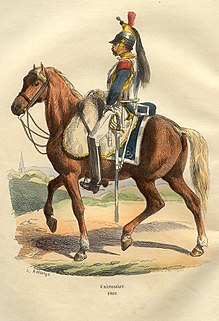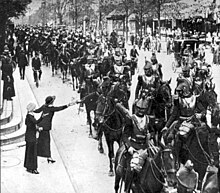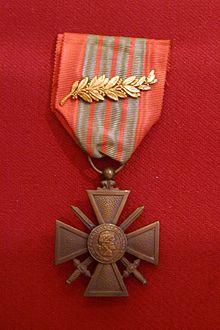5 e regiment de cuirassiers
|
Régiment de cavalerie etrangère |
|
|---|---|
 Internal association badge |
|
| Lineup | 1653 |
| Country |
|
| Armed forces |
|
| Armed forces |
|
| Branch of service | Cavalry (armored force) |
| Type | Regiment de Cuirassiers |
| Insinuation | Unités outre-mer |
| Location | Camp Zayed Abu Dhabi |
| Nickname | le Royal-Pologne |
| Patron saint | Saint George of Lydda |
| motto | Nec pluribus impar & "De meilleur il n'en est pas" |
| Colours | blue / silver |
| Anniversaries | April 23 |
| equipment | Main battle tank Leclerc |
| Awards | Croix de guerre 1914-18 / 1939-45 & Croix de guerre des Théâtres d'opérations extérieures |
The Régiment de cavalerie etrangère (currently 5 e régiment de cuirassiers - 5th cuirassier regiment) is a cavalry association of the Ancien Régime or a tank regiment of the French army. By order of the king, it was built from May 1, 1653 and placed under the command of the Duc de Navailles, who thus became the first mestre de camp (commander) of the regiment. In the same year the regiment passed to the Comte de Nogent, lost the name "Régiment de Cavalerie Etrangère" and was named after the owner in accordance with the customs of the time. (However, this only applied to those regiments that were not given an important name from the start, for example because a high-ranking member of the royal family was designated as the owner.)
In 1725 King Louis XV replaced the regiment from its then owner, the Marquis de Monteils, and after his marriage handed it over to his father-in-law Stanislaus I. Leszczyński , the former King of Poland . From then on, the regiment was called "Roi Stanislas cavalerie" or just "Stanislas-Roi". Since then, the regiment has also featured the white Polish eagle in its coat of arms.
With a royal order dated March 30, 1737, it was then renamed the “Régiment Royal Pologne cavalerie” and the king made himself the owner.
In republican France, like all others, it was only given a number. During the First Empire and the Restoration , it was given a name again, only to be referred to as “5 e régiment de cuirassiers” from 1830 onwards
The regiment was disbanded in 1992.
In 2016 it was re-established in the United Arab Emirates as a replacement for the withdrawn " 13 e demi-brigade de la légion étrangère ".
After the "13 e demi-brigade de la légion étrangère (DBLE)" was withdrawn from Abu Dabi and relocated to the Camp de la cavalerie in Larzac, the 5th e régiment de cuirassiers set up again and stationed at Camp Zayed in Abu Dhabi. The restoration ceremony took place with the participation of Général d'armée Jean-Pierre Bosser , commander in chief of the land forces.
The regimental commander is Colonel Arnaud Goujon.
Mestres de camp / Colonels / Chefs de brigade
Mestre de camp was the rank designation for the regimental owner and / or the actual commander. Should the Mestre de camp be a person of the high nobility who had no interest in leading the regiment (e.g. the king or queen), the command was given to the Mestre de camp lieutenant (or Mestre de camp en second). The name Colonel was used from 1791 to 1793 and from 1803, from 1793 to 1803 the name Chef de brigade was used . From 1791 there were no more regimental owners.
- 1653: De Nogent;
- 1656: De Vaubrun;
- 1658: De Nogent;
- 1672: De Saint-Ruth;
- 1674: De Saint-Germain;
- 1692: De Gournay;
- 1694: De Cossé-Brissac;
- 1704: De Magnières;
- 1710: De Monteils;
- 1725: Stanislas-Roi;
- 1737: Royal-Pologne (the king himself)
- 1791: 5 e regiment de cavalerie
- 1803: 5 e regiment de cuirassiers
- 1814: Cuirassiers de Berry
- 1815: 5 e regiment de cuirassiers
- 1816: Cuirassiers d'Orléans
- 1830: 5 e regiment de cuirassiers
- 1916: 5 e cuirassiers à pied (dismounted)
- 1919: 5 e regiment de cuirassiers
- 1940: dissolved
- 1945: re-established as the 5 e régiment de cuirassiers
- 1954: dissolved
- 1958: re-established as the 5 e régiment de cuirassiers
- 1961: dissolved
- 1962: re-established as the 5 e régiment de cuirassiers
- 1992: dissolved
- 2016: re-established as the 5e régiment de cuirassiers
Battle calendar
- Fight in the crushing of the Fronde rebellion
-
Franco-Spanish War (1635-1659)
- 1658 Battle of the dunes under Turenne
- From 1672 to 1678 the regiment fought in Holland, Germany and Flanders . ( Dutch War )
- In 1684 it was involved in the Reunion War
- 1688 to 1697: Fights in the Palatinate War of Succession
- 1701 to 1712: Fighting in the War of the Spanish Succession on the Rhine , in Italy and in Spain .
- In the War of the Quadruple Alliance , the regiment distinguished itself in the siege of San Sebastian and Hondarribia in Spain in 1719 .
- 1733 to 1735: Fighting in Germany in the War of the Polish Succession
- From 1740 to 1748 he took part in the War of the Austrian Succession
with fights in Austria and Germany. Award for fighting in the Battle of Dettingen . This was followed by relocation to the Spanish Netherlands . Fight in the Battle of Roucoux
- 1756 to 1763: Participation in the Seven Years' War - battle near Korbach
-
Coalition wars
- 1792 to 1794: First coalition war, fighting with the " Armée des Alpes "
- 1794 Suppression of the uprising in the Vendée
- 1794 to 1799: Italian campaign with the "Armée d'Italie" - Battle of Rivoli
- 1800 Second coalition war with the "Armée des Grisons"
- 1805–1807: Third Coalition War and Fourth Coalition War with the Grande Armée - Battle of Austerlitz , Battle of Prussian Eylau
- Campaign in Spain
- 1809: Fifth Coalition War - Battle of Wagram - Battle of Aspern (In this battle the regiment lost its eagle )
- 1812: Russian campaign - Battle of Borodino
- 1813/14: Participation in the Wars of Liberation with battles in Germany and France
- 1815: Battle of Waterloo
- 1823: French invasion of Spain
- 1831: Mobilization of the regiment and march to Belgium on the occasion of the ten days campaign
- 1870–1871: Franco-Prussian War Surrender of the regiment after the Battle of Sedan
First World War
When the First World War broke out , the regiment was stationed in Tours . Under the command of Colonel De Cognac, it mobilized on August 4, 1914. It was part of the "9th Division de Cavalerie" (9th Cavalry Division) and had first contact with the enemy on August 10, 1914 near Marville . It carried out liaison and security services until August 1, when the horses were handed over and converted into a cavalry rifle regiment. From then on it was given the name "5 e régiment de cuirassiers à pied" (5th cuirassier regiment on foot). On August 17, 1916, it was relocated to the front by motor vehicle, where it was in the area of Lihons ( Canton Chaulnes ) on the night of August 17 to 18 . was inserted. On August 27th the regiment was completely assembled here.
This was followed by positional and movement battles for the further duration of the war in the "Bataille de l'Yser" ( First Battle of Flanders ) at the "Bataille de l'Avre" Battle of Amiens (1918) and in the "Bataille de l'Aisne (1918) “( German Spring Offensive 1918 ) In January 1918 the regiment also formally lost the cuirass , but in 1919 it was converted back into a (motorized) cuirassier regiment.
Interwar period
In 1935 the French army had five cavalry divisions. The regiment belonged to the "2 e division de cavalerie" (2nd cavalry division) and formed in this, together with the "18 e régiment de chasseurs à cheval" (18th regiment of hunters on horseback), the "3 e Brigade de Cavalerie" ( 3rd Cavalry Brigade)
Second World War
On May 10, 1940, the regiment belonged to the "5 e division légère de cavalerie" (5th light cavalry division) of the "II e armée française" (II French army), which was under the command of General Huntziger . The association crossed the Belgian border and reached the Virton - Arlon line , where the first German reconnaissance forces were repulsed. The division was forced by the pressing German troops to retreat across the French border, where it was initially placed in reserve and at the disposal of the "groupement Roucaud" and then took over the flank protection at the Battle of Stonne . After the front was withdrawn on May 23, 1940, the unit was placed at the disposal of the “7 e Armée” (7th Army) and relocated to Senlis . By May 31st, the complete “3 e brigade de cavalerie” (3rd cavalry brigade) gathered to go to the “9 e corps d'armée” (9th army corps) as a reserve . On June 12, 1940, the "5 e division de cavalerie" was surrounded by Saint-Valery-en-Caux . To lack of ammunition to escape suffering and without the possibility, the 5 gave e DLC of the 7th Armored Division under the command of General Rommel .
Indochina
- From February 5, 1946 to March 1, 1954, the regiment fought in Indochina
1954-1992
Stationed in Kaiserslautern since 1962 , the regiment was part of the "3 e brigade mécanisée" (3rd mechanized brigade) of the 1 re division blindée (1st armored division) in the "Quartier Hoche Marceau" of the former German Holtzendorff barracks.
Until July 1968 the structure of the regiment consisted of:
- 3 escadrons of three platoons each of 5 M47 battle tanks
- 1 Escadron of four platoons with 5 AMX-13 tank destroyers each
- 1 Escadron porté
After being equipped with the AMX-30 main battle tank from spring 1969, the previous structure was changed to:
- 4 escadrons of 4 platoons of 3 battle tanks each
- 1 Escadron porté with 4 trains of three AMX-13 tank destroyers each
2016
The re-establishment did not take place as a pure tank regiment, but as a mixed unit:
- 1 Escadron with 15 Leclerc battle tanks and 14 Véhicules blindés légers ( VBL )
- 1 infantry company with 14 Véhicules blindés de combat de l'infanterie ( VBCI )
- 1 support company with:
- 5 CAESAR protected system
- 4 Véhicules de l'avant blindé ( VAB ) génie (armored engineer platoon)
- 2 Leclerc armored recovery vehicles (DCL)
- 5 Véhicules poste de commandement (Staff and command vehicle - VPC)
The total number of soldiers amounts to 270 soldiers, 57 of them are permanently stationed, 213 are regularly replaced.
Current vehicle equipment
Garrisons
- 1852 Caserne Neufchâtel in Reims
- 1879 Quartier Ordener in Senlis
- 1891 Reims
- 1899–1914 Tours
- 1919-1920 Commercy
- 1920-1924 Gray
- 1929-1933 Pontoise
- 1938-1939 Valdahon
- 1945–1954 Indochina
- 1958-1952 Vannes
- 1962–1992 Kaiserslautern
- 2016– Zayed military city Abu Dhabi
Standards
The regiment changed its standards several times:
- 1725 when it was renamed Roi Stanislas ,
- 1737 when it was renamed Royal Pologne ,
- 1791 in the course of the revolution (no longer royal),
- 1804 under Napoleon I as Emperor of the French
- 1814 under King Louis XVIII. ( First restoration )
- 1815 under Napoleon I ( rule of the hundred days )
- 1815 under King Louis XVIII. ( Second restoration )
- 1848 after the end of the revolution and the introduction of the republic
- 1852 in the second empire
- 1871 after the abolition of the empire
This last version, with the honorable mentions, was in use until the unit was dissolved. The gold embroidered inscriptions read:
- Rivoli 1797
- Austerlitz 1805
- Wagram 1809
- La Moskova 1812
- L'Yser 1914
- L'Avre 1918
- L'Aisne 1918
- Indochine 1946-1954
The standard is decorated with:
- The Fourragère des Croix de guerre 1914–1918 with two palm branches
- The Fourragère des Croix de guerre 1939–1945 with a palm branch
- The Fourragère des Croix de guerre des Théâtres d'opérations extérieures (Croix de guerre for foreign missions) with two palm branches
Uniforms of the Ancien Régime
Motto
The regiment's motto was:
Uniforms and armaments
When they were set up, the riders wore light gray uniforms with red trimmings. In addition, a black tricorn with a silver braid and a cuirass, which was later replaced by a breastplate under the uniform skirt. The armament consisted of a saber , a musket and a pair of pistols attached to the saddle .
1725
The cuirassiers were now given a blue uniform, as is customary for the royal regiments. The badge color was red, pants and waistcoat were white with a three-cornered hat as before, but the hat received an iron calotte to catch saber blows. The breastplate was only worn on parades and in the field. (However, details changed several times until the revolution.)
1779
From 1779 the uniforms were cut more closely (l'habit à la française) and the regiment was given the badge color carmoisine (carmine red). The trousers were a pale yellow-brown, the buttons were white metal. The officers wore no badges of rank until 1763 , after which the Mestre de camp received two epaulettes, the "Lieutenants" ( lieutenants ) and "Sous-lieutenants" (sub-lieutenants) wore an epaulette on their left shoulder. They were made of spun silver and mixed with red silk. The trumpeters wore a royal livery (richly decorated)
After 1791
With the decree of 1791 and during the time of the revolution, nothing serious changed in the uniform apart from minor details. Only after the renaming to "Régiment de curassiers" did the riders receive a short blue jacket and were again equipped with chest and back armor. Short scarlet fur in the shape of a vest was put on under the armor. The hat was replaced by the characteristic helmet with the horse's tail.
In 1805 the helmet was additionally decorated with a feather trim, and red epaulettes were put on by the teams and NCOs . The red cuffs were decorated with blue garnets, the symbol of the elite associations.
The regiment wore this uniform almost unchanged until the outbreak of war in 1914 and for some time afterwards.
Sponsorships
Footnotes
- ↑ Composed of foreign mercenaries
- ↑ z. As the king, the queen or the heir apparent (Dauphin), but also important provinces like the Picardie the Bourgogne or the dominion of the Condé
- ↑ As in the other countries, it was recognized that the end of the battle cavalry had come and another six cuirassier regiments (4th / 6th / 8th / 9th / 11th / and 12th) were converted into rifle regiments
- ↑ Historique du 5 e regiment de cuirassés.
- ↑ so the French name
- ↑ until 1725 is only a standard
- ↑ Two versions are known here
- ↑ Décision n ° 12350 / SGA / DPMA / SHD / DAT du 14 septembre 2007 relative aux inscriptions de noms de batailles sur les drapeaux et étendards des corps de troupe de l'armée de terre, du service de santé des armées et du service des essences des armées, Bulletin officiel des armées, n ° 27, November 9, 2007
See also
literature
- General de brigade Philippe Peress: L 'histoire du 5e régiment de curassiers de 1653 a nos jours. Beranger & fils, Paris 1998.
- Musée des Blindés ou Association des Amis du Musée des Blindés 1043, route de Fontevraud, 49400 Saumur.
- François Vauvillier, revue Histoire de guerre, blindés et matériels , n ° 79 et 80 articles de La division cuirassée en 1940 et ses perspectives. 2007-2008.
- Dominique Lormier: Comme des lions - May June 1940 - Le sacrifice héroïque de l'armée française. édition Calmann-Lévy, 2008, ISBN 978-2-7021-3445-0 .
- Marcel Goya: La chair et l'acier. L'invention de la guerre moderne (1914 à 1918) Paris 2004.
- Jean-Jaques de Nauyon de Curmont: Les uniformes et les drapeaux de l'armée du roi . 3 volumes
-
Denis Diderot , Jean le Rond d'Alembert: Encyclopédie ou Dictionnaire raisonné des sciences, des arts et des métiers . Paris 1751–1772 - 28 volumes.
Available under École militaire (France) in the French-language Wikipedia - P. Charrié: Drapeaux et étendards du Roi. Léopard d'Or, 1989
- R. Chartrand: Louis XV's Army. (1). Osprey, 1996
- R. Chartrand: Louis XV's Army. (3). Osprey, 2003
- R. Chartrand: Louis XV's Army. (4). Osprey, 1997
- R. Chartrand: Louis XV's Army. (5). Osprey, 1998
- Albert Rigondaud: Le Plumet - l'uniformes et les drapeaux de l'armée de l'Ancien régime et du 1er Empire . Paris 1971.
- Lucien Rousselot: L'Armée Française - ses uniformes, son équipement, son armement . 1969.


























